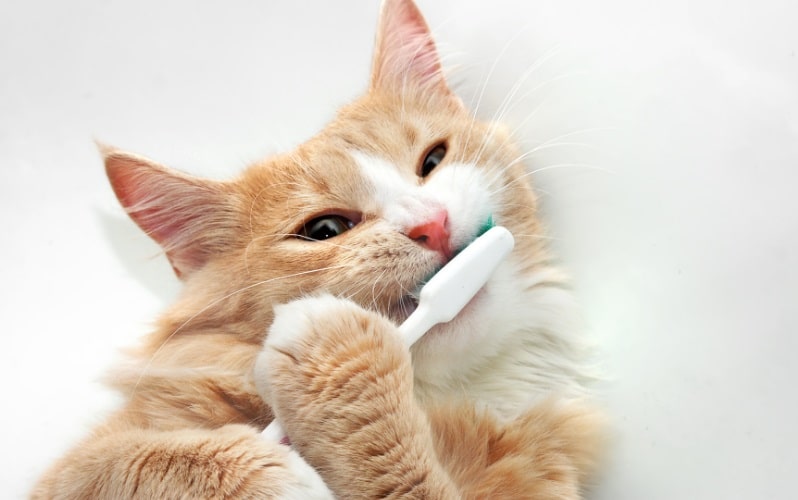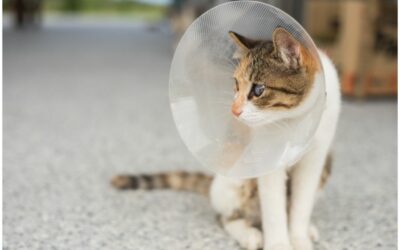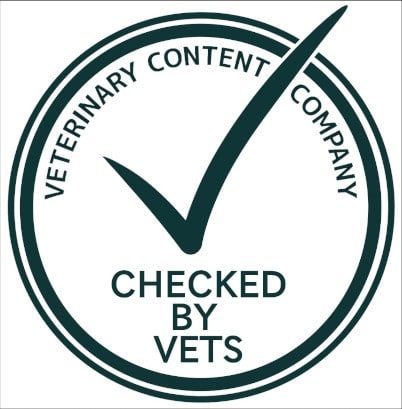
The information in this article has been checked for medical accuracy by Dr. Joannna Woodnutt. However, it is not meant to be used as a substitute for diagnosis or advice from your local vet.
The mouth is home to millions of bacteria. Some are harmless, others can spell trouble if left unchecked. While most people make an effort to take care of their own oral health and schedule a checkup appointment with the dentist every so often, oral diseases in cats tend to go overlooked for months or even years. Today we are talking about one of the major diseases that can result from poor oral health: periodontal disease.
What is periodontal disease in cats?
Periodontal disease is a condition in which bacteria are able to penetrate and multiply in gum tissues of the mouth, eventually resulting in severe complications. This condition is also known as periodontitis among vets, or less formally as gum disease.
Plaque formation
As we eat, our teeth will naturally accumulate a creamy film on their surface, which we call plaque. Plaque is essentially a sticky coating that consists of millions of bacteria.
This layer is the result of tiny food particles that get stuck between the teeth. If these particles are not removed, they provide an ideal layer for bacteria to grow on.
Removing plaque is simple – you can brush your cat’s teeth at home with a pet toothbrush – but when it stays there, over time the plaque will interact with calcium to form tartar (also known as calculus). Tartar is a lot harder to remove; it’s a tough layer that is firmly stuck to the teeth.
Gingivitis
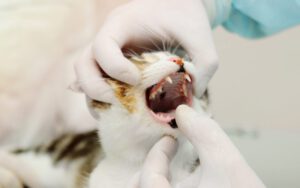
Tartar will start to dig into the gum tissues. They become sore and red, which means your cat now has gingivitis. This inflammation is an effort of the body to control all that bacterial growth. As bacterial growth and inflammation get worse, eventually the part of the tooth that is normally protected beneath the lining of the gums will slowly but surely become exposed. Once tartar has dug deep enough into the gums, new bacteria are constantly able to penetrate below the gum line. This infection of deeper tissue will result in further complications.
The four stages of periodontal disease
Periodontal disease goes through four distinct stages. The type of treatment needed is highly dependent on the severity (or how far the teeth and gums have started to decay).
Stage 1 – Plaque formation:
As we eat, our teeth will naturally accumulate a creamy film on their surface, which we call plaque. Plaque is essentially a sticky coating that consists of millions of bacteria.
This layer is the result of tiny food particles that get stuck between the teeth. If these particles are not removed, they provide an ideal layer for bacteria to grow on.
Removing plaque is simple – you can brush your cat’s teeth at home with a pet toothbrush – but when it stays there, over time the plaque will interact with calcium to form tartar (also known as calculus). Tartar is a lot harder to remove; it’s a tough layer that is firmly stuck to the teeth.
Stage 2 – Gingivitis:
If the sticky film is not removed in stage 1, it will eventually turn into tartar.
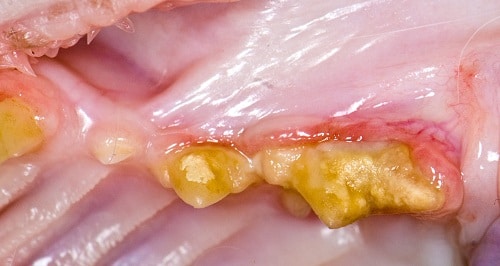
Tartar will start to dig into the gum tissues. They become sore and red, which means your cat now has gingivitis. Inflammation of the tissue is an effort of the body to stop the bacterial growth. The gum tissues start to recede further and become inflamed.
The gap between tooth and gum that is formed during this process will provide an opportunity for even more food particles to get trapped and more plaque to accumulate, resulting in increased bacterial growth and infection of surrounding tissues.
If left untreated, there will eventually be a slow progression to stage 3, but this can take years and often remains undetected until it is too late.
Stage 3 – Periodontitis
Bacteria below the gum line are secreting high amounts of toxic substances that cause further tissue damage. These bacteria, as well as the inflammation and tissue damage they cause, often stimulate the cat’s immune system. The immune system brings in white blood cells in order to destroy the invaders. This process will damage the supporting soft tissues around the tooth.
As bacterial growth and inflammation get worse, eventually the part of the tooth that is normally protected beneath the lining of the gums will slowly but surely become exposed. Once tartar has dug deep enough into the gums, new bacteria are constantly able to penetrate below the gum line. This infection of deeper tissue will result in further complications.
We can now officially speak of periodontal disease since the tissue that surrounds the tooth (called the periodontium) is red and swollen.
Stage 4 – Roots become infected:
As these pockets between the tooth and the surrounding gums get larger, the process accelerates and this causes the gums to recess even further. Finally, the roots of the teeth come to lay bare (stage 4). At this point, entire teeth or even parts of the jawbone may be lost forever.
In periodontal disease stage 4, it is crucial that you start treatment as soon as possible. If left unchecked, stage 4 can eventually lead to major infections and severe feelings of malaise. It can even result in critical organ failure and death when left untreated.
Symptoms of periodontal disease in cats
Periodontal disease in cats can easily go undetected for months. It is often only discovered once the infection and accompanying inflammation become so painful that the cat is no longer able to hide all the signs of discomfort. Even then, most people would still need their cat checked by a specialist to find out what is going on.
Common symptoms of advanced gingivitis include:
- Leaky nose
- Swelling of the mouth
- Loss of appetite
- Recessed and red swollen gums
- Grinding of the teeth
- Yellow/black discoloring of the teeth
- Easily agitated
- Stinky breath
- Bleeding gums
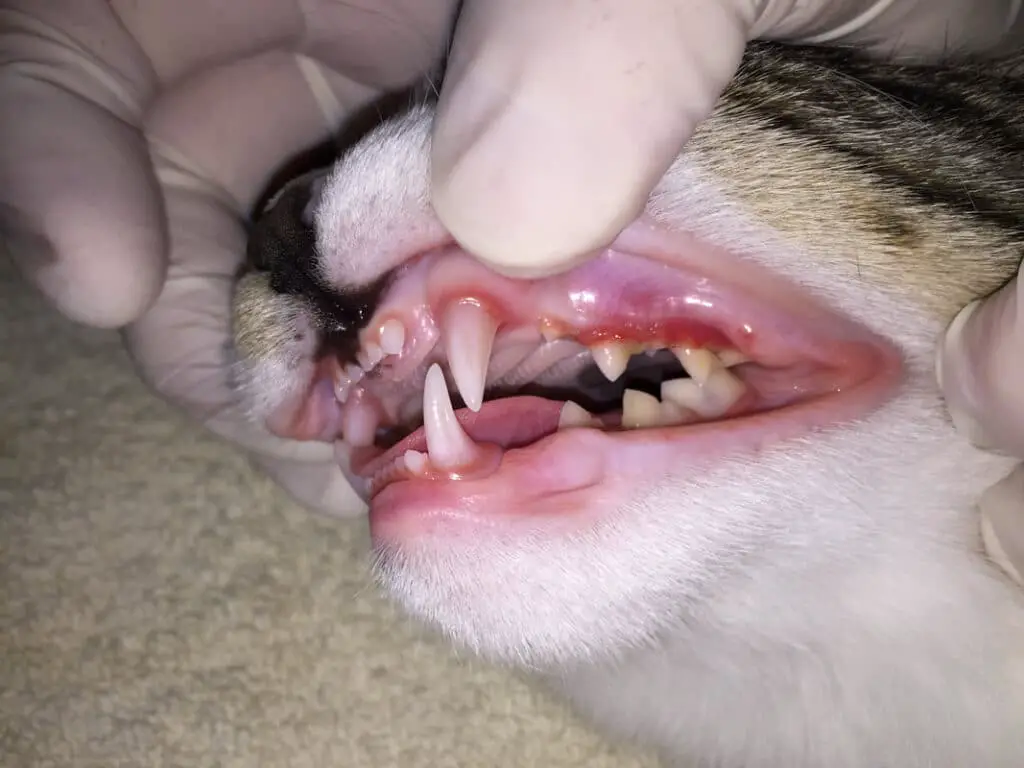
Treatment
Once the vet has established that your cat suffers from periodontal disease, you will be advised to start a treatment. The contents of this treatment highly depend on the severity of the disease.
Stage 1
Early stages of periodontal disease can be treated by increasing the frequency and quality of oral care. This involves brushing your cat’s teeth every day, both on the teeth and along the lining of the gums. If needed, there are additional products available to reduce plaque, such as plaque wipes and dental water additives.
Stage 2
In more advanced stages of periodontal disease, a thorough dental cleaning under general anesthetic may be necessary to remove all tartar. While there are ‘anesthesia-free dental cleanings’, most vets actually advise against this. Any gaps between the gums and teeth need proper cleaning, and they have to be closed to prevent reinfection. This is simply too painful for a conscious cat.
Stage 3 & 4
Once periodontal disease has progressed to stage 3 and 4, cats may need to have entire teeth removed. This is a delicate procedure that requires professional surgery – teeth snap easily, and the specialist needs to make sure that the entire root is removed. There is also a small risk that the jaw bone breaks during extraction.
Generally speaking, the sooner you detect gum disease in your cat, the easier it is to treat. Earlier stages of decay also have a much lower chance of having to extract teeth and further complications.
How to prevent periodontal disease in cats

A recent survey found that around 70% of pet owners never brush their pets’ teeth. Sadly, this is the easiest way to maintain oral hygiene. We highly recommend you do an inspection of your cat’s mouth once a month and brush away any plaque deposits to prevent gum disease.
The best technique is to teach your cat to let you pull her cheeks back to check the teeth – make sure to make it fun and reward them with a treat!
Related: How to brush your cat’s teeth at home (A complete guide)
Other useful products
Several other products are also available to assist in keeping your cat’s teeth in tiptop shape. Dental treats, plaque wipes, water additives, and special diet food can all be helpful. Consult your veterinarian to aid in the prevention of gingivitis.
The Veterinary Oral Health Council (VOHC) awards a seal of approval to products that have scientific evidence of efficacy. They list the suitable cat products here: http://www.vohc.org/VOHCAcceptedProductsTable_Cats.pdf
What brush and toothpaste should I use?
One of the most efficient ways of maintaining good oral hygiene is by brushing with a special cat brush. Never use a toothbrush designed for humans, as it’s too rough and can cause a lot of damage to the delicate structures in a cat’s mouth.
As for toothpaste, you can not use human toothpaste. Buy one specifically made for pets, as these do not contain the irritating ingredients that we find in human toothpaste. According to our vet Joanna, cats generally prefer flavored kinds of toothpaste such as this fish-flavored one.
Sources:
https://vcahospitals.com/know-your-pet/cat-care/promoting-wellness/common-cat-dental-problems
Frequently asked questions
Gingivitis presents as a dark red inflammation on the contact line between a tooth and the gum that surrounds it. When the gingivitis is caused by plaque and tartar, you’ll see evidence of this on the teeth- they are often discolored, with a yellow-blackish tint.
However, cats can also have gingivitis when there is no sign of tartar, so the gums are the most important place to look.
Certain foods may create more build-up of food particles. However, it’s not as simple as ‘dry food stops cat getting dental problems’, as this has been shown to be incorrect. Speak with your veterinarian about what you can do in terms of diet to keep your cat’s teeth healthy.
The same way humans get treated: by seeing a dentist for a thorough cleaning. It is no different for your cat, as the vet will have to do the exact same cleaning procedures. In severe cases of feline periodontal disease, one or multiple teeth might have to be extracted.
If left untreated, periodontal disease can eventually result in death. If periodontal disease is not treated properly it will result in prolonged suffering and pain. In severe cases, the bacteria from an infected tooth or gum may be able to enter the bloodstream and cause more infections and organ damage throughout the body. In these cases, it is vital that your cat is put on the right antibiotics.
That usually depends on how far the infection has progressed. Periodontitis is an irreversible process after a point. For cases of gingivitis and very early periodontitis, a good brushing after meals should start to reduce the symptoms in two to three weeks. However, once the disease has started to take hold it’s likely your cat will need repeated dental cleanings, extractions, and home care.
No, wet food does not directly cause gingivitis and periodontal disease. But since cats are meant to use their teeth to grind down solid food, putting your cat on a diet of exclusively wet food will hinder the natural process of eroding plaque. However, a dry-food diet won’t stop your cat from getting dental diseases. In reality, it’s a lot more complex than that. See our nutrition page for more information.
That depends on the stage and whether there is periodontitis present as well. There are some special diet foods on the market that effectively help control the growth of bacteria and the formation of plaque, so these are often recommended- but if your cat has severe problems and their teeth need to be removed, your vet may recommend a softer diet to help them with eating.
Brushing is the most effective way to improve your cat’s oral hygiene. But not all cats will easily accept it! Special diets, diet additives, water additives, treats, and other options are available- your vet will be able to advise, or you can look for ideas on the VOHC website.
Plaque wipes are a decent alternative for cats that are not so fond of the toothbrush.
Did we miss anything? Let us know in the comments!

